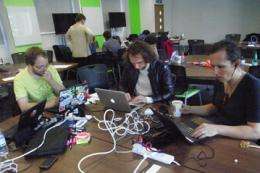Using social and web technologies in disaster responses

Developing software and solutions to real-world problems was the aim of the h4d2 hackathon event held at Aston University.
Emergency experts and software developers from across Europe attended the two day event, which was designed to investigate the use of social media and web technologies in disaster responses.
Recent disasters such as the earthquakes in Haiti and Japan have highlighted how social media (e.g. Twitter, Facebook, Ushahidi) and Web 2.0 technologies as well as the increasing availability of publicly available structured data are beginning to affect all aspects of disaster management.
The Conference explored a range of areas, including how to best make relevant data easily accessible to key personnel and the use of online street maps in emergencies.
Speakers at the Conference included representatives from the United Nations; the , the Sahana Foundation and the Hexayurt project.
National fire-services and the World Bank were also among the key industry experts in attendance, with direct experience of handling disaster situations.
Dr Christopher Brewster, Principal Investigator of Disaster 2.0, said: "h4d2 proved an excellent opportunity for emergency management experts and software developers to collaborate and develop solutions that will have practical benefits for disaster responses. I would like to thank the European Commission for their financial support which has enabled us to hold h4d2."
H4d2 was held as part of the project exploring how governments across Europe currently and can potentially use Web 2.0 applications and Semantic Technologies in disaster response. A second Hackathon for Disaster Response will be held in April 2013.
Videos of the presentations are available on the h4d2 website.
Provided by Aston University

















